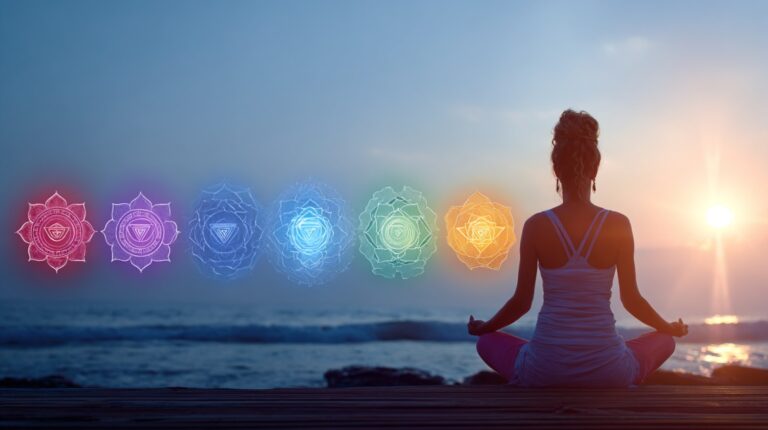Chakras in yoga are viewed as centers of energy aligned along the spine, influencing physical, emotional, and spiritual health.
- Tension
- Anxiety
- Lack of vitality
Yoga offers a practical method to align and balance these centers by combining mindful postures, controlled breathing, and visualization.
Today, we will talk about the most important chakras activated through practicing yoga.
1. Mountain Pose (Tadasana)
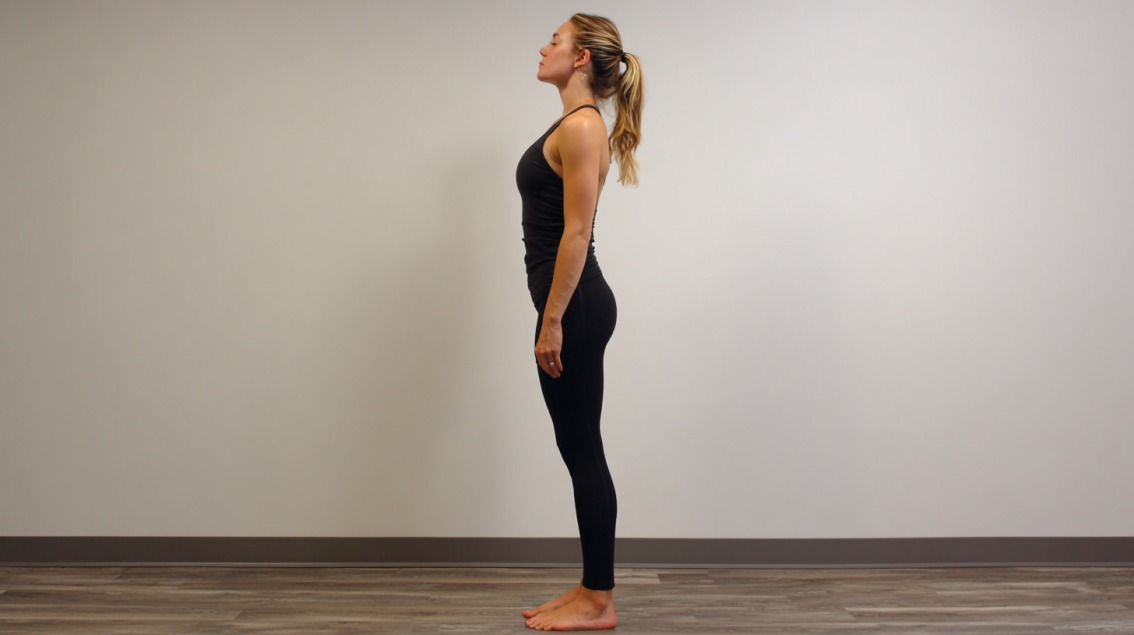
- Chakra: Root (Muladhara)
Mountain Pose represents stability and grounding, making it the foundation of chakra practice. Begin by standing with feet hip-width apart, pressing evenly into the ground through all four corners of each foot.
Lift the kneecaps slightly by engaging the thighs while tucking the tailbone gently downward.
Lengthen the spine, broaden the collarbones, and let arms rest naturally alongside the body with palms open. Keep the gaze forward, soft yet steady, as if aligning with the horizon.
Visualize a radiant red glow at the base of the spine, spreading down through the legs into the earth.
Imagine roots growing downward, anchoring you firmly. Silently repeat the mantra “LAM,” resonating with the root chakra, to strengthen the connection to stability and security.
Benefits: This posture improves posture, aligns the spine, and strengthens the legs. Practicing Tadasana nurtures feelings of safety, grounding, and balance in daily life. Anxiety and restlessness often ease as energy becomes centered in the root chakra.
2. Bound Angle Pose (Baddha Konasana)
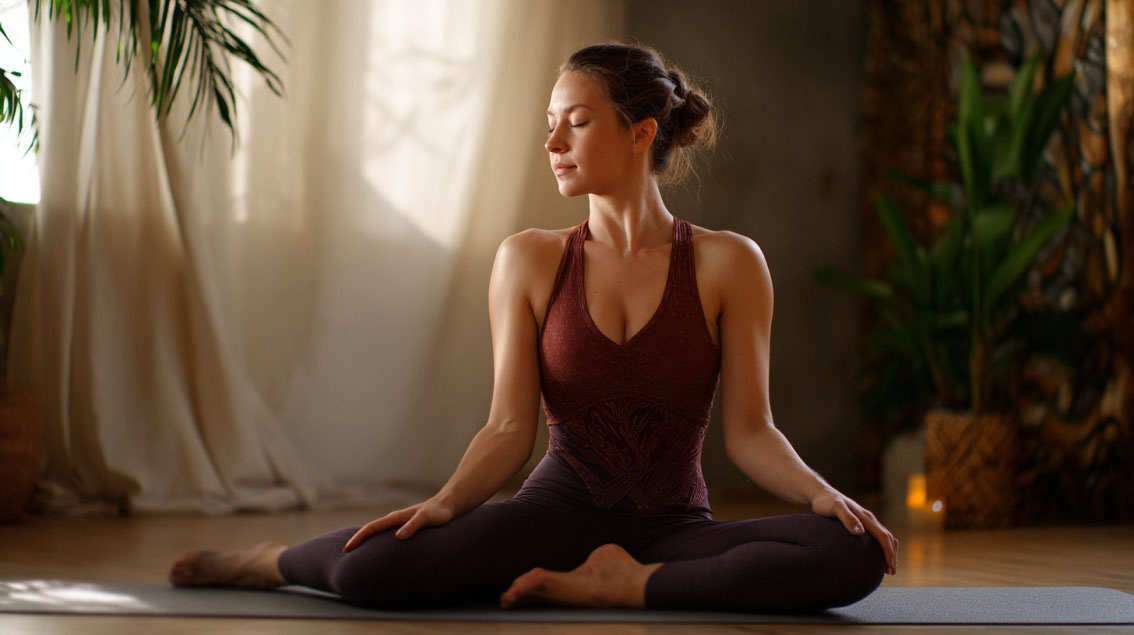
- Chakra: Sacral (Svadhisthana)
Sit on the mat with legs bent, bringing the soles of the feet together while allowing the knees to fall open naturally. Hold the feet or ankles with both hands, keeping the spine long.
Shoulders remain relaxed as you gently press the knees toward the floor without force. Focus on a steady breath, inhaling deeply into the lower abdomen.
Visualize a warm orange glow radiating in the pelvic area, symbolizing creativity and emotional flow. Mantra “VAM” can be repeated silently to awaken this energy center.
Benefits: Bound Angle Pose improves hip flexibility and stimulates the reproductive and urinary systems. On an energetic level, the pose releases stored emotions and encourages creativity, sensuality, and openness in relationships.
3. Boat Pose (Navasana)
- Chakra: Solar Plexus (Manipura)
Start seated with legs extended forward. Lean back slightly while engaging the core, then lift both legs off the ground so the body forms a “V” shape.
Extend arms parallel to the floor, palms facing each other, and keep the chest lifted. Maintain a steady breath and gaze forward to help with balance.
Visualize a golden flame glowing in the abdomen, growing brighter with every inhale. Repeat the mantra “RAM” to stimulate inner fire, personal strength, and determination.
Benefits: Boat Pose builds core strength, tones abdominal muscles, and improves digestion. Energetically, it empowers self-confidence, willpower, and focus by activating the solar plexus chakra. Practicing this posture helps release fear and doubt, replacing them with clarity and determination to move forward with purpose.
4. Camel Pose (Ustrasana)
View this post on Instagram
- Chakra: Heart (Anahata)[/su_note]
Kneel on the mat with knees hip-width apart. Place palms on the heels or lower back for support, then arch the chest upward and gently allow the head to fall back.
Hips press forward as the chest expands fully. Breathing becomes deeper and more open in this posture, lifting energy upward through the heart space.
Visualize a vibrant green light radiating from the center of the chest, expanding outward with compassion and love.
Repeat the mantra “YAM” to align the heart chakra with openness and connection.
Benefits: Camel Pose opens the chest, shoulders, and lungs, improving respiration and circulation. On an emotional level, it supports forgiveness, compassion, and the release of grief or fear. Heart chakra activation through this posture cultivates balance between giving and receiving love.
5. Bridge Pose (Setu Bandhasana)
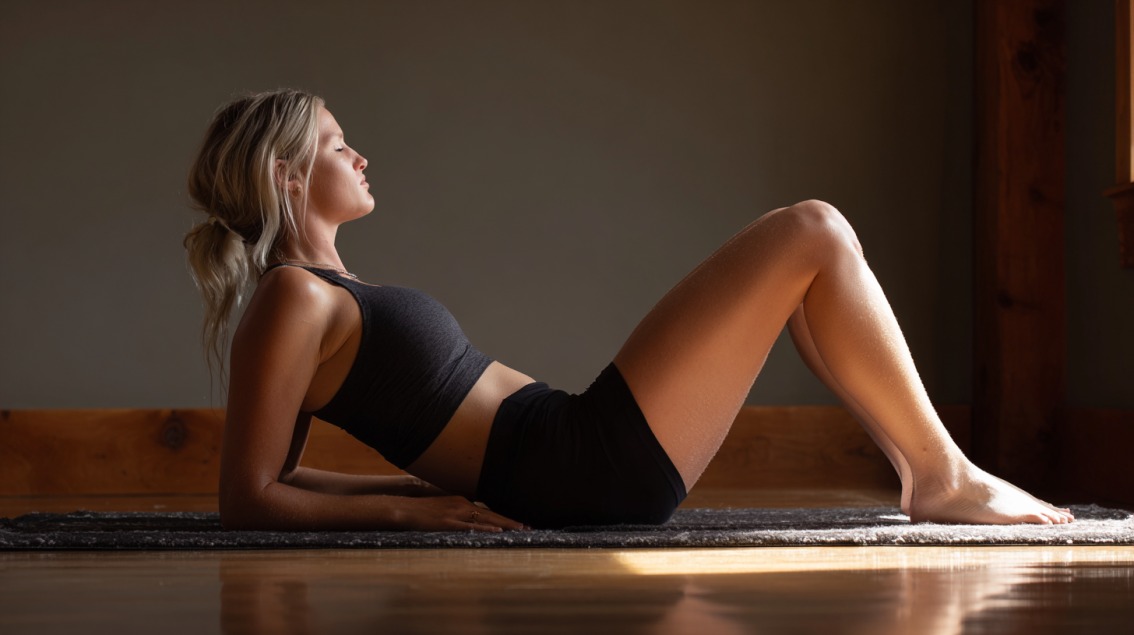
- Chakra: Throat (Vishuddha)
Lie on your back with knees bent and feet hip-width apart, close to the sitting bones. Press feet into the mat while lifting the hips upward.
Interlace fingers beneath the body and roll shoulders inward to create more chest expansion. Keep the gaze soft, focusing upward or toward the heart.
Visualize a bright blue light shining at the throat, representing clarity and authentic expression. Repeat the mantra “HAM” to support communication and truth.
Benefits: Bridge Pose strengthens the spine, glutes, and hamstrings while stimulating the thyroid gland. Energetically, it balances the throat chakra, encouraging honest self-expression and communication. Practicing this posture regularly helps dissolve fear of speaking out and cultivates confidence in expressing ideas and emotions clearly.
6. Child’s Pose (Balasana)
View this post on Instagram
- Chakra: Third Eye (Ajna)[/su_note]
Kneel on the mat with big toes touching and knees apart. Fold forward, resting the torso between the thighs and the forehead on the floor.
Arms may extend forward or rest alongside the body with palms facing upward. Breathing should be slow and steady, creating a sense of surrender.
Visualize indigo light glowing between the eyebrows, expanding into the head. Silently repeat the mantra “OM” to activate intuitive awareness.
Benefits: Child’s Pose calms the nervous system, stretches the lower back, and reduces stress. On a deeper level, it strengthens intuition, enhances clarity, and promotes trust in inner guidance. Practicing this posture cultivates peace, helping one tune into subtle messages of the mind and spirit.
7. Corpse Pose (Savasana)
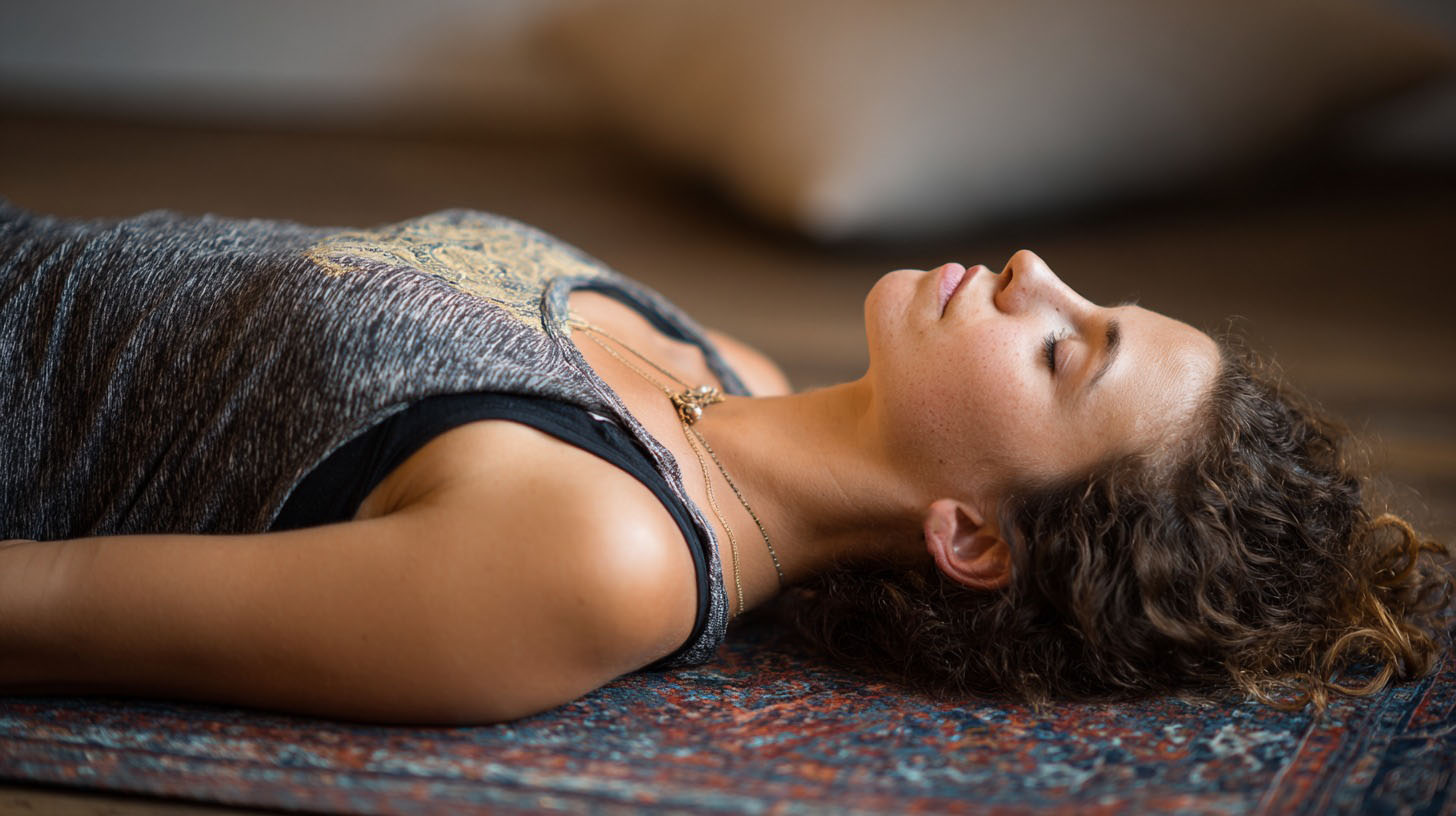
- Chakra: Crown (Sahasrara)
Lie flat on the mat with legs extended and arms resting comfortably by the sides. Palms face upward, and the body remains completely relaxed.
Allow the eyes to close and surrender every muscle into stillness.
Visualize a white or violet glow radiating above the crown of the head, symbolizing connection with universal energy. Mantra “OM” may be repeated silently to open the crown chakra.
Benefits: Corpse Pose promotes complete relaxation, reduces stress, and rejuvenates the body. On a spiritual level, it fosters connection to higher consciousness and inner peace. Regular practice enhances meditation, awareness, and the sense of being supported by universal energy.
8. Cobra Pose (Bhujangasana)
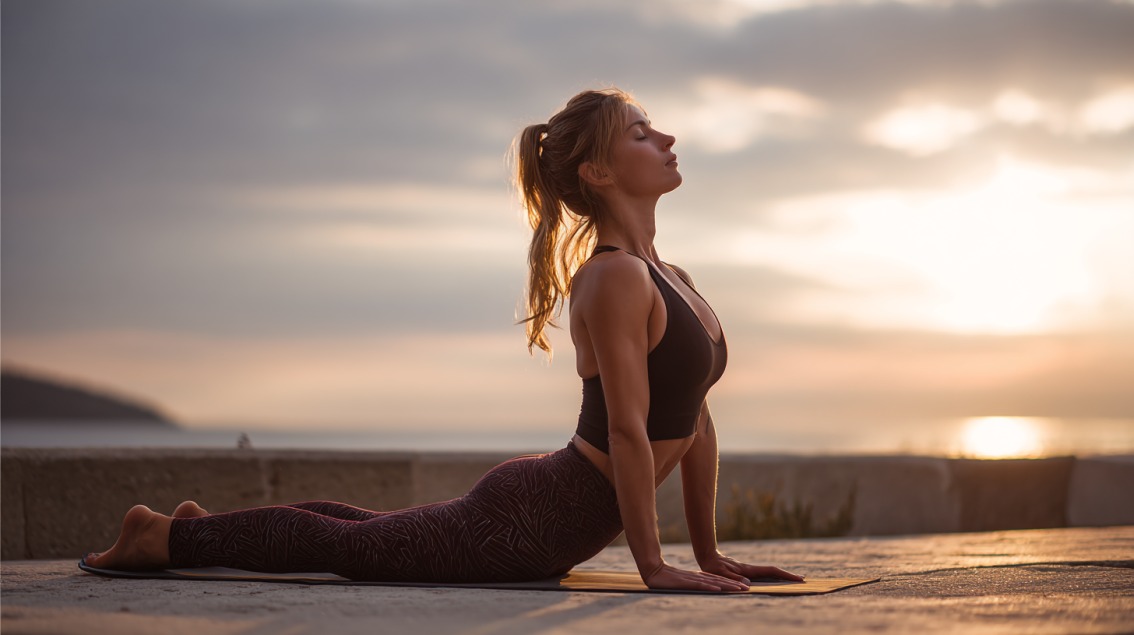
- Chakra: Sacral/Solar Plexus
Lie on the stomach with hands beneath the shoulders. Press into the palms, lifting the chest while keeping elbows close to the body.
Shoulders roll back as the heart opens forward. Keep the lower body grounded while lifting energy through the torso.
Visualize orange and yellow light radiating through the pelvis and abdomen. Repeat both mantras “VAM” and “RAM” to balance creative flow and inner strength.
Benefits: Cobra Pose strengthens the spine, tones abdominal muscles, and stimulates digestive organs. Energetically, it harmonizes creativity and willpower, creating balance between emotional flow and personal strength. Practicing regularly builds resilience while enhancing energy levels.
9. Warrior I (Virabhadrasana I)
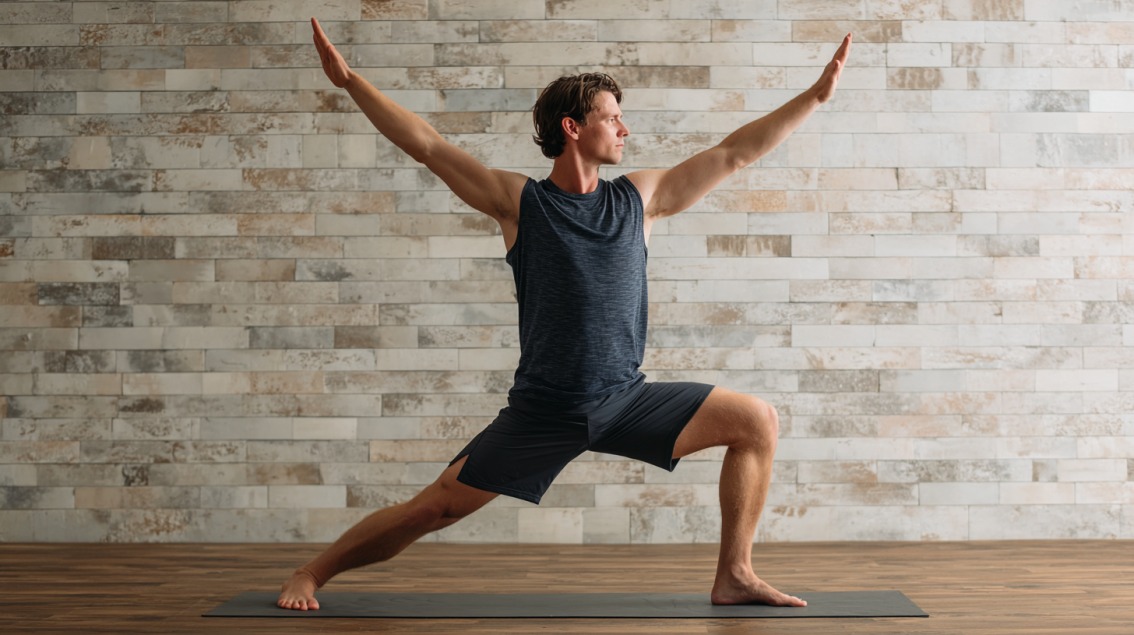
- Chakra: Root/Solar Plexus
Step the right foot forward into a lunge, keeping the left leg extended behind with the heel grounded.
Bend the front knee at a 90-degree angle while raising arms overhead, palms facing each other. Keep the torso facing forward and chest lifted.
Visualize red light at the base of the spine combined with a yellow flame in the abdomen, symbolizing grounded strength and determination. Repeat mantras “LAM” and “RAM” to awaken both chakras.
Benefits: Warrior I builds stamina, tones the legs, and opens the chest. On an energetic level, it balances grounding with empowerment. Practicing this pose nurtures courage, determination, and the ability to pursue goals with stability and confidence.
10. Seated Forward Bend (Paschimottanasana)
- Chakra: Root (Muladhara)
Sit with legs extended forward, feet flexed, and spine lengthened. Inhale to lift the chest, then exhale to fold forward, reaching for the feet or shins. Keep the back long rather than rounded, and breathe deeply into the pose.
Visualize a red light glowing at the base of the spine, expanding downward into the earth. Repeat the mantra “LAM” to strengthen grounding energy.
Benefits: Seated Forward Bend stretches the hamstrings, spine, and shoulders. It calms the mind, relieves stress, and creates stability. Root chakra activation through this posture enhances grounding, security, and connection to the physical body.
How Yoga Supports Chakra Balancing
Yoga is more than a physical exercise; it is a practice that harmonizes body, mind, and energy. Each movement or posture encourages prana, the life force, to flow freely through the body.
Energy travels along the central channel known as the sushumna nadi, which runs through the spine and connects all chakras.
When blockages exist, tension, fatigue, or emotional imbalance may arise. Through mindful practice, yoga helps release those blockages, creating a balanced energetic state.
Asanas, or postures, are essential tools in chakra balancing. Each posture targets specific regions of the body where chakras are located. Grounding postures such as Mountain Pose connect energy to the root chakra, while heart-opening backbends like Camel Pose stimulate the heart chakra.
Inversions can influence the crown chakra, guiding awareness upward toward spiritual connection. Breathwork amplifies these effects by enhancing oxygen flow and prana circulation, while meditation builds awareness of subtle shifts in vibration.
- Physical release: Asanas reduce muscular tension and improve circulation, helping prana move without resistance.
- Energetic awakening: Postures stimulate areas of the spine associated with chakra centers, activating energy.
- Emotional balance: Conscious breath and mindful poses ease stress and regulate emotions.
- Spiritual awareness: Meditation and stillness create clarity, guiding awareness toward higher consciousness.

Consistency is crucial in this process. Subtle alignment and energetic transformation develop over time. Regular practice helps establish stability, clarity, and resilience, encouraging long-term emotional and spiritual well-being.
Visualization & Breath Techniques
Visualization and breathwork greatly enhance the effects of chakra-focused yoga. While holding a posture, focusing on a specific color linked to each chakra deepens the practice. Colors not only serve as symbols but also act as energetic reminders.
For example, red imagery grounds the root chakra, while violet light stimulates crown chakra awareness. To strengthen this effect, practitioners often pair visualization with sound or mantra repetition.
- Root (Muladhara): Red – stability and security
- Sacral (Svadhisthana): Orange – creativity and emotional flow
- Solar Plexus (Manipura): Yellow – confidence and willpower
- Heart (Anahata): Green – compassion and love
- Throat (Vishuddha): Blue – expression and truth
- Third Eye (Ajna): Indigo – intuition and wisdom
- Crown (Sahasrara): Violet or white – spiritual connection
Breathwork, or pranayama, plays an equally important role. Techniques encourage energy to rise and balance throughout the body. For example, alternate nostril breathing balances the right and left hemispheres of the brain.
A 4-7-8 rhythm calms the nervous system and encourages stillness. Paired with color visualization, pranayama transforms physical postures into energetic practices.
Mantras, known as bija or seed sounds, also awaken chakra centers. Vibrational chanting creates resonance in specific areas of the body.
- LAM for the root chakra
- VAM for the sacral chakra
- RAM for the solar plexus chakra
- YAM for the heart chakra
- HAM for the throat chakra
- OM for the third eye chakra
- Silence or OM for the crown chakra
Visualization, pranayama, and mantras work in synergy to align energy. Practitioners who integrate these elements with yoga postures experience profound benefits, ranging from physical stability to heightened spiritual awareness. Consistent practice fosters both personal growth and inner peace.
Summary
Regular practice of chakra-based yoga fosters balance, awareness, and vitality.
Integrating these poses with breathwork and visualization techniques supports subtle energetic transformation. Progress requires patience, as chakra healing unfolds gradually.
Treat the process as an ongoing practice that nurtures both body and spirit.

